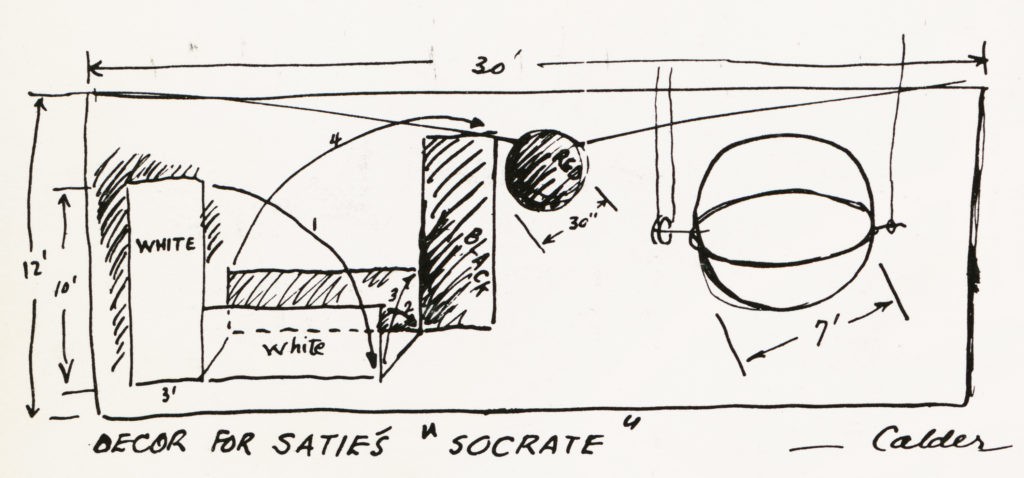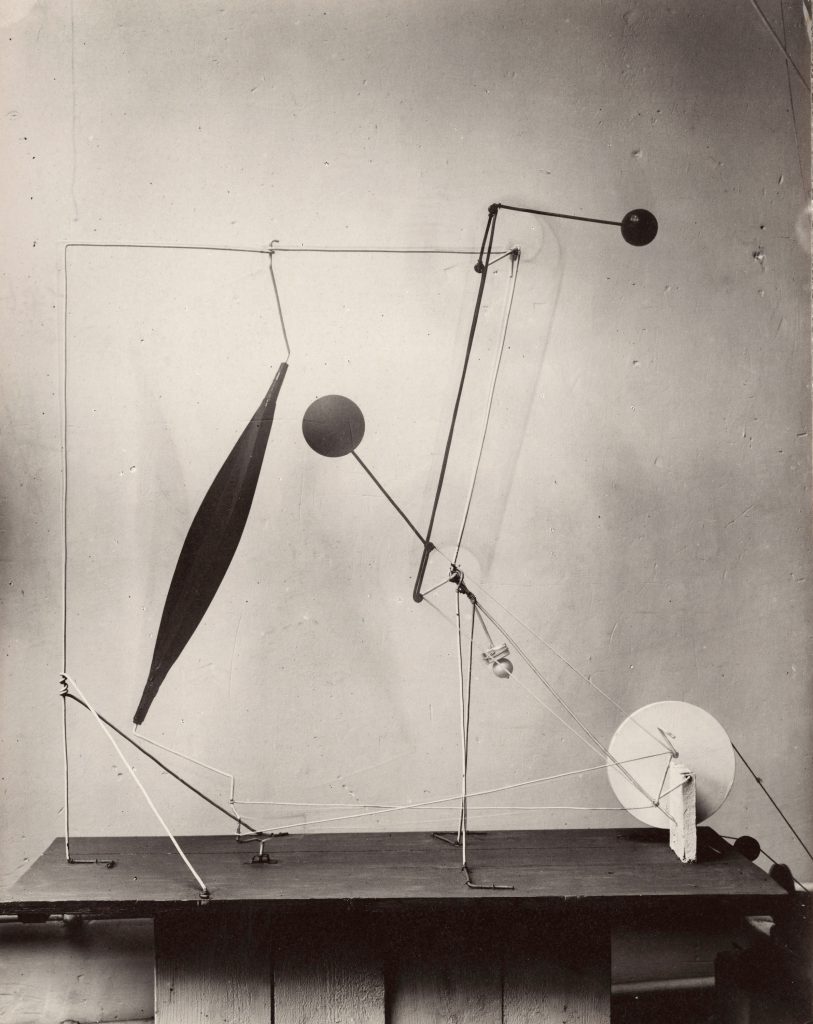Featured Text
Mobiles
The Painter’s Object, edited by Myfanwy Evans. London: Gerald Howe, 1937.
The Painter’s Object, edited by Myfanwy Evans. London: Gerald Howe, 1937.
When an artist explains what he is doing he usually has to do one of two things: either scrap what he has explained, or make his subsequent work fit in with the explanation. Theories may be all very well for the artist himself, but they shouldn’t be broadcast to other people. All that I shall say here will be about what I have already done, not about what I am going to do.
I began by studying engineering. But after four years I decided that engineering did not allow enough play of ingenuity on my part. When I was working in a logging camp I first started painting. I went to New York, and then to Paris, where I started making wire toys—caricatures of people and animals, some of them articulated. Then I made things in wood, taking a lump of wood and making very little alteration in its shape—just enough to turn it into something different. Then I made a circus with elephants, horses, a lion, Roman chariots and so on: basically of wire, but with cork and wood and bright colours added. Most of these objects also were articulated, so that they made characteristic gestures. The material for this was based on my observation at the circus, and on drawings of it. I was always interested in circuses.
My father was a sculptor and my mother a painter, but it was quite accidentally that I became mixed up with modern art. Through a neighbour who knew about modern art—he had read the books, and so on—I went to see Mondrian. I was very much moved by Mondrian’s studio, large, beautiful and irregular in shape as it was, with the walls painted white and divided by black lines and rectangles of bright colour, like his paintings. It was very lovely, with a cross-light (there were windows on both sides), and I thought at the time how fine it would be if everything there moved; though Mondrian himself did not approve of this idea at all. I went home and tried to paint. But wire, or something to twist, or tear, or bend, is an easier medium for me to think in. I started with a few simple forms. My first show was at the Galerie Percier, of simple things ranged on a plank against a wall. In a way, some of those things were as plastic as anything I have done. They did not move, but they had plastic qualities. Then I made one or two things that moved in a slight degree. I had the idea of making one or two objects at a time find actual relationships in space.


I did a setting for Satie’s Socrate in Hartford, U.S.A., which I will describe, as it serves as an indication of a good deal of my subsequent work.
There is no dancing in it. It is sung by two people—a man and a woman. The singing is the main thing in it. The proscenium opening was 12 feet by 30 feet. There were three elements in the setting. As seen from the audience, there was a red disc about 30 inches across, left centre. Near the left edge there was a vertical rectangle, 3 feet by 10 feet, standing on the floor. Towards the right, there were two 7 foot steel hoops at right angles on a horizontal spindle, with a hook one end and a pulley the other, so that it could be rotated in either direction, and raised and lowered. The whole dialogue was divided into three parts: 9, 9, and 18 minutes long. During the first part the red disc moved continuously to the extreme right, then to the extreme left (on cords) and then returned to its original position, the whole operation taking 9 minutes. In the second section there was a minute at the beginning with no movement at all, then the steel hoops started to rotate toward the audience, and after about three more minutes they were lowered towards the floor. Then they stopped, and started to rotate again in the opposite direction. Then in the original direction. Then they moved upwards again. That completed the second section. In the third, the vertical white rectangle tilted gently over to the right until it rested on the ground, on its long edge. Then there was a pause. Then it fell over slowly away from the audience, face on the floor. Then it came up again with the other face towards the audience; and that face was black. Then it rose into a vertical position again, still black, and moved away towards the right. Then, just at the end, the red disc moved off to the left. The whole thing was very gentle, and subservient to the music and the words.
For a couple of years in Paris I had a small ballet-object, built on a table with pulleys at the top of a frame. It was possible to move coloured discs across the rectangle, or fluttering pennants, or cones; to make them dance, or even have battles between them. Some of them had large, simple, majestic movements; others were small and agitated. I tried it also in the open air, swung between trees on ropes, and later Martha Graham and I projected a ballet on these lines. For me, increase in size—working full-scale in this way—is very interesting. I once saw a movie made in a marble quarry, and the delicacy of movement of the great masses of marble, imposed of necessity by their great weight, was very handsome. My idea with the mechanical ballet was to do it independently of dancers, or without them altogether, and I devised a graphic method of registering the ballet movements, with the trajectories marked with different coloured chalks or crayons.
I have made a number of things for the open air: all of them react to the wind, and are like a sailing vessel in that they react best to one kind of breeze. It is impossible to make a thing work with every kind of wind. I also used to drive some of my mobiles with small electric motors, and though I have abandoned this to some extent now, I still like the idea, because you can produce a positive instead of a fitful movement—though on occasions I like that too. With a mechanical drive, you can control the thing like the choreography in a ballet and superimpose various movements: a great number, even, by means of cams and other mechanical devices. To combine one or two simple movements with different periods, however, really gives the finest effect, because while simple, they are capable of infinite combinations.
Calder, Alexander. “Mercury Fountain.” Stevens Indicator, vol. 55, no. 3 (May 1938).
MagazineCalder, Alexander. “A Water Ballet.” Theatre Arts Monthly, vol. 23, no. 8 (August 1939).
MagazineSweeney, James Johnson. “Alexander Calder: Movement as a Plastic Element.” Plus, no. 2 (February 1939).
MagazineMasson, André. “L’Atelier d’Alexander Calder.” Handwritten poem, 1942. Calder Foundation, New York.
Unpublished Document or ManuscriptIn 1937, Calder completed Devil Fish, his first stabile enlarged from a model. He received two important commissions: Mercury Fountain (1937) and Lobster Trap and Fish Tail (1939). His first retrospective was held in 1938 at the George Walter Vincent Smith Gallery in Springfield, Massachusetts, followed by another in 1943 at the Museum of Modern Art in New York.